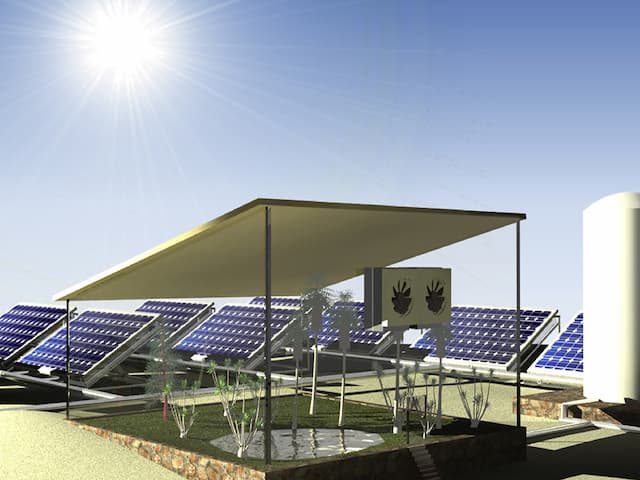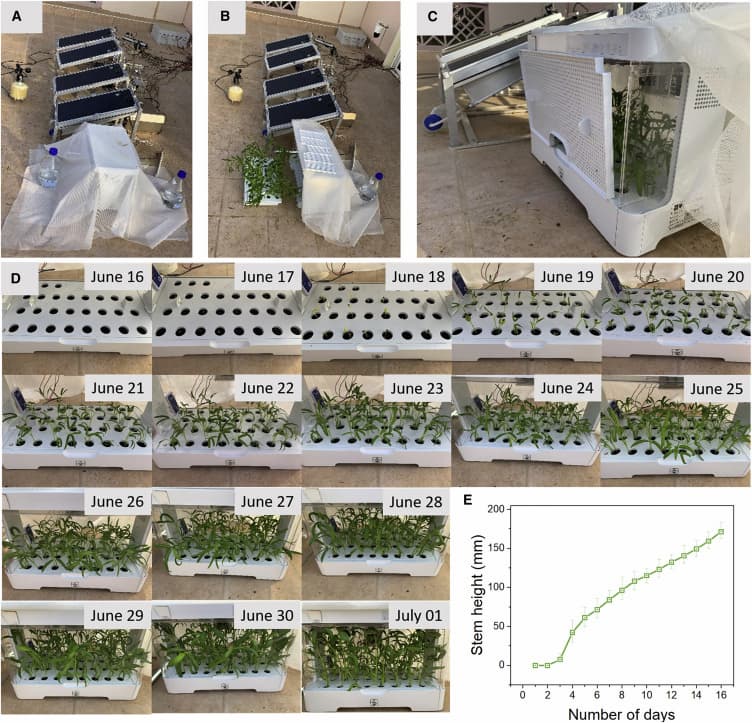
a team of scientists used Solar panels for cooling cells, drinking & growing crops in desert by pulling in water from air vapor !
The impact of climate change goes beyond rising temperatures only, as climate change affects all aspects of life, including agriculture, food, water resources and wildlife, particularly in arid desert areas, barren lands without planting or water, so that the only option for us is to produce water from the air, which is literally what this promising project from King Abdulaziz University in Saudi Arabia offers.
Isolated areas
In isolated, arid and semi-arid areas, the central tide of both electricity, drinking water and long-distance transport in these areas is impractical and cost-effective due to lack of financial resources as well as low population density. At the same time, it is believed that a decentralized approach is most appropriate for the economic provision of electricity and water to those remote areas.
To address the problem, scientists at King Abdullah University of Science and Technology have introduced an integrated solar-based system that provides a low-cost source of renewable energy, water and food and thus provides life-saving benefits to those people living in remote and arid areas of the world. It’s a great multi-potential system that can solve multiple problems.
Water from air
The new innovative system is called the “Co-Production System for Water and Electrical Crops” or “WEC2P”.
The new system relies on solar cells equipped with a cooling system that uses hydrogel to capture heat for the purpose of cooling solar cells, intensifying water vapor and then using it for drinking and irrigating agricultural crops.
Hydrogel is a water-loving polymer, with hydrogel-lined solar panels mounted on top of a large metal box, which converts water vapor from the air into irrigation and drinking water used to grow crops.
The system is designed to have two modes of operation:
- AWH-PV cooling mode where water is used to cool cells (Figure B)
- AWH-Water water production and crop production mode (Figures A and C).

The sunlight is absorbed and partially converted into electricity by photovoltaic cells, with the rest, usually more than 80% of absorbed sunlight converted to heat, improving the temperature of PV panels.
The AWH cooling layer consists of: –
- Anti-corrosion polyethylene film (PE) (≤0.04 mm in fish)
- Atmospheric water vapor absorbents, i.e. calcium chloride and polyacrylamide (PAM-CaCl2) hydrogel.The heat of the PV cell pushes water to evaporate from the absorbent material during the day, effectively reducing the PV temperature.
Reducing the temperature of solar cells
Using this system, researchers were able to reduce the temperature of PV panels by up to 17 °C and increase electricity generation by up to 10%, a huge leap since most solar panels are only able to convert about 20% of the solar energy they are exposed to into electricity. By combining irrigation, agriculture and photovoltaic cells, this design makes promising progress for a type of integrative solar energy known as agricultural PV cells.
Producing water from the air
The atmosphere constantly preserves nearly 13,000 billion tons of fresh water pre-distilled or increased, and atmospheric water is constantly replenished through global water circulation. Solar-based atmospheric water harvesting can meet the 5-liter-per-day drinking water requirements per person for more than 2 billion people around the world, according to a recent study. Thus, using atmospheric water as an alternative water resource can be a promising approach to addressing water and energy shortages in off-grid communities and arid or semi-arid areas.
WeC2P was able to produce approximately 3.4 liters of water over a month using a 30*60 PV solar panel and after proving the concept, the researchers aim to develop the system to produce more water to meet an individual’s daily needs.
Agriculture in isolated areas
In the dry climate in Saudi Arabia, the research team tested a concept model using spinach seeds for two weeks last summer. Even with exceptionally hot weather, the experiment resulted in a 95% success rate, with 57 out of 60 seed sprouted grown to a normal height using only 2 liters of water condensed by the system itself. In addition to a total of 1500 watts/hour of electricity.

Low-cost system
This technology follows a sustainable low-cost strategy to provide food, water and energy under arid conditions, with pam-CaCl 2 costing less than $1, although the combined cost of building and deploying such a system will be much more, and in addition to crop development, harvesting water vapor from the air provides clean drinking water.
While demonstrating the concept that shows very promising results, before converting the model into a product, the team will develop a more absorbing hydrogel that can generate more water.
“A small part of the world’s population still has no access to clean water or green energy, many of whom live in rural areas with a dry or semi-dry climate.” “Our design makes water from the air using clean energy that could have been wasted and is suitable for small, decentralized farms in remote places such as deserts and oceanic islands.”
Dr. Wang, lead author of the study
Large-scale PV cells are a key tool in any strategy to avoid a global climate crisis. However, like any advanced technology, PV cells come with a host of problems of their own. Known for its inefficiency in hot climates, PV cells are extremely limited in the desert, one of the few environments that are exposed to solar energy almost continuously during the day and with unlimited potential for clean energy.
At the same time, climate change leads to water shortages and desertification, a process in which formerly hospitable environments become truly arid lands. According to the World Health Organization, more than 2 million people live without safe drinking water, 800 million lack any electricity and 700 million suffer from famine.
Summary
The new system has several advantages, including:
- Cooling of PV panels, which contributes to a 10% increase in electricity generation performance
- Recycling wasted heat from photovoltaic panels to produce fresh water from the atmosphere equivalent to two liters of water over a two-week period and researchers are seeking to increase this rate
- Integrated system that produces electricity with fresh water and crops
- Application with minimal geological and geographical limitations
Source of study

Leave a Reply